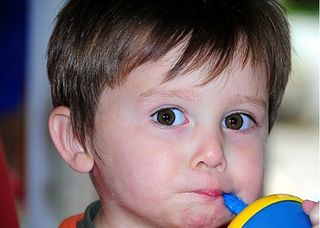
Brad, who has just turned three, was adopted by Fred, a medical intern, and his wife, Cher. Last year Brad spent four days a week in daycare, since Cher needed to work part time and was told Brad would benefit socially.
Brad’s teachers reported that when Brad didn’t get his way, he expressed his frustration and anger by hitting others, wildly trashing about, refusing to take redirection. During this last month, however, Brad was learning to use language in lieu of hitting. When his teachers threatened to report a recent incident to his parents, he immediately shot back, threatening to report them instead.
While continuing to engage his teachers by wildly trashing about, Brad, full of fun-loving antics, was still by far their favorite.
About two weeks ago, Fred told me that Brad awakened during the night screaming, running from his room, jumping into bed with him and Cher. Fred thought it a nightmare, possibly emanating from a violent robot TV serial Brad had been watching. I immediately asked myself if this could it be a symptom of childhood anxiety that could play out in multiple forms of mental illness as he grows older.
I speculated with Fred that yes, Brad was threatened by something imagined in a dream. But it was important that Brad be encouraged to verbalize it, as best he could, to externalize the threat and be rid of it. If Brad can use language to freely examine his own feelings, whatever they may be, he will be better able to prevent the festering anxiety and internal conflicts that lead to serious mental issues.
Fred said he was confused. “How can language prevent threats of goblins, evil spirits, and dread of the dead.
I replied that language actually created these fears since they are learned from what others tell us. The only innate fears I was aware were loud thunderous sounds and falling in space. We learn to deal with thunder by becoming inured over time to the sound. Falling into space, however, can be a lifelong survival instinct for us not to get too close to the precipice.
Fred asked why it was that others created goblins, ghosts, and threatening spooky creatures. I replied that these scary inventions were used by others to control us to be submissive and pay our taxes.
“But how does all this relate to preventing childhood anxiety,” Fred asked?
Well, I replied, first of all, it means that childhood anxiety is largely learned, not innate. Secondly, if we can teach our children to be anxious, it means we can teach them not to be anxious. And third, if we can teach them to manage their own feelings with language, they will then be free from having mental hang-ups that can be being exploited by others.
“Exploited?” Fred remarked.
When you pull back and look at it, all of us have been manipulated, taken advantage of, or outsmarted—it all amounts to the same. We may think we are free agents, particularly when it comes to thinking our own thoughts. Yet, as three-year-olds, we use language not just to communicate with others but, just as important, with ourselves.
The problem is that significant others, however well-minded, begin to impose dysfunctional language patterns upon us, forcing us to think in terms of right or wrong, black or white, good or evil, etc. This thinking becomes highly problematic when dealing with those holding different beliefs and values, creating irreconcilable conflict. It also promotes feelings of guilt and anxiety for holding spiteful thoughts toward one’s family members or fear of committing a social booboo in public.
“But how am I and Cher supposed to prevent Brad from having spiteful thoughts toward us and becoming socially anxious?” Fred asked.
Well, the first thing you want to do is to not lavishly praise his good behavior. He’s not a dog. He needs to learn what is functional and dysfunctional behavior own his own, sometimes with your help in sitting down and helping him see the probable outcomes of one choice over another. If he makes a poor choice, so be it—we learn from our mistakes—by not considering the likely consequences of one choice over another.
“But what if Brad turns out to have some genetically predisposed hyperactive or personality disorder? Fred pressed on.
He’s still a human being and deserves respect as a person. Yes, you can impose time-out as a consequence for repeated dysfunctional behavior, but not without helping him see that it is a likely outcome of a poor choice. The idea is to have Brad begin to think for himself, taking responsibility for his own behavior, and being free from the dictates, however disguised, of manipulative authority.
When it comes to Brad getting along with others who may hold different beliefs and values, you might enlist Brad’s creative imagination to pretend that he is the parent and you and Cher are the children. You can also play back some of Brad’s challenging antics to see what he makes of them. Not only does this exercise promise to be fun, but you will learn what Brad perceives as your beliefs and values, which may or may not come as a shock.
Fred asked if all this wasn’t a bit much for a three-year-old.
Of course, I replied, but it depends on the child. Playing reverse roles is great fun. Not only will Brad love you for it, but it will cement a close relationship that can withstand the inevitable fissures of beliefs and values that occur over time.
*
This blog was co-published with PsychResilience.com




